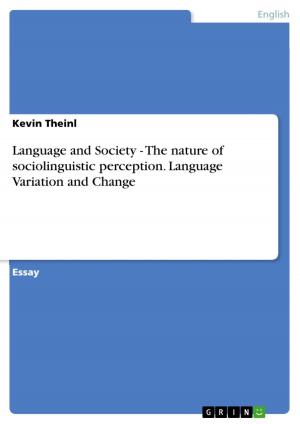Mary Rowlandson's captivity narrative - Applied Puritan ideology?
Fiction & Literature, Literary Theory & Criticism, British| Author: | Christian Weckenmann | ISBN: | 9783640096145 |
| Publisher: | GRIN Publishing | Publication: | March 26, 2008 |
| Imprint: | GRIN Publishing | Language: | English |
| Author: | Christian Weckenmann |
| ISBN: | 9783640096145 |
| Publisher: | GRIN Publishing |
| Publication: | March 26, 2008 |
| Imprint: | GRIN Publishing |
| Language: | English |
Research Paper (undergraduate) from the year 2007 in the subject English Language and Literature Studies - Literature, grade: 1,3, University of Heidelberg (Anglistisches Seminar), course: Hauptseminar Literaturwissenschaft: Conceptualizing the 'Savage': Ethnic Perspectives in Early American Literature (William Bradford to Hermann Melville), language: English, abstract: The way the Puritans approached, valued and treated the Indians in America is intrinsically tied to their religious belief and the religious concepts they applied to order the world they lived in. With an authentic non-fictional account of a Puritan minister's wife about her captivity among Indians, as delivered by Mary Rowlandson, there is the unique chance of analyzing the application of Puritan principles of belief in time of hardship as well as Puritan reception of the Indian American. The following pages will attempt to interpret Rowlandson's behavior in captivity and her description of the natives against the background of her religion. The focus will be placed on the way Rowlandson employs Puritan ideology in order to make sense of the world and especially of her experiences in Indian captivity. More precisely, this essay intends to answer the following central questions: Firstly, how and to what degree does Rowlandson actually succeed in explaining the happenings to herself and fellow Puritans, or to put it differently - how does she deal with inconsistencies between religious doctrines and reality? Secondly, does Rowlandson succeed in living according to Puritan principles while in captivity? Lastly and on the findings of the previous answers, does her captivity among the Indians cause any alteration in her attitude towards them?
Research Paper (undergraduate) from the year 2007 in the subject English Language and Literature Studies - Literature, grade: 1,3, University of Heidelberg (Anglistisches Seminar), course: Hauptseminar Literaturwissenschaft: Conceptualizing the 'Savage': Ethnic Perspectives in Early American Literature (William Bradford to Hermann Melville), language: English, abstract: The way the Puritans approached, valued and treated the Indians in America is intrinsically tied to their religious belief and the religious concepts they applied to order the world they lived in. With an authentic non-fictional account of a Puritan minister's wife about her captivity among Indians, as delivered by Mary Rowlandson, there is the unique chance of analyzing the application of Puritan principles of belief in time of hardship as well as Puritan reception of the Indian American. The following pages will attempt to interpret Rowlandson's behavior in captivity and her description of the natives against the background of her religion. The focus will be placed on the way Rowlandson employs Puritan ideology in order to make sense of the world and especially of her experiences in Indian captivity. More precisely, this essay intends to answer the following central questions: Firstly, how and to what degree does Rowlandson actually succeed in explaining the happenings to herself and fellow Puritans, or to put it differently - how does she deal with inconsistencies between religious doctrines and reality? Secondly, does Rowlandson succeed in living according to Puritan principles while in captivity? Lastly and on the findings of the previous answers, does her captivity among the Indians cause any alteration in her attitude towards them?















